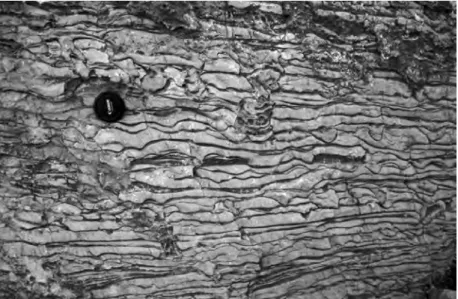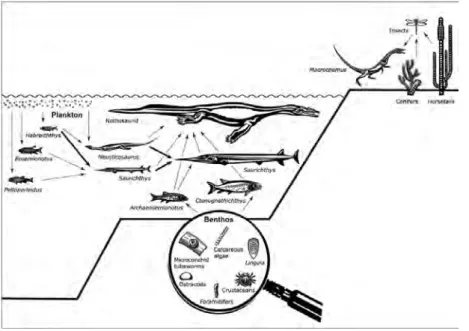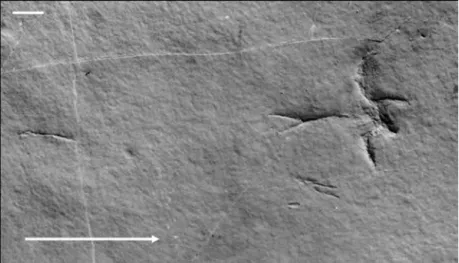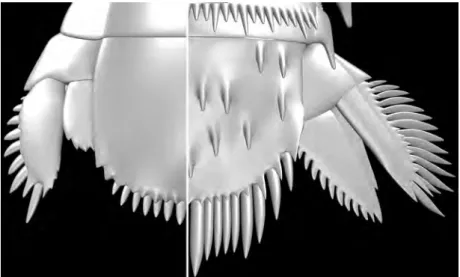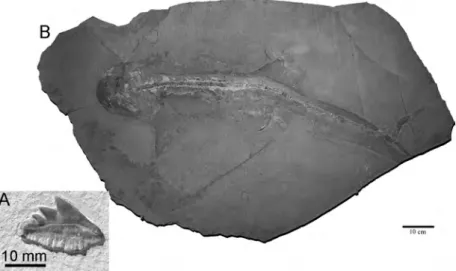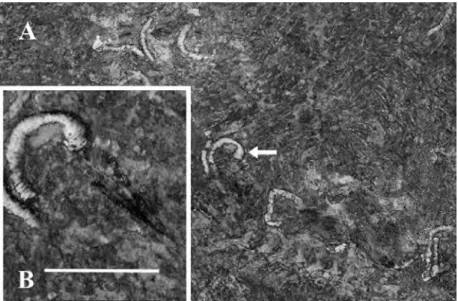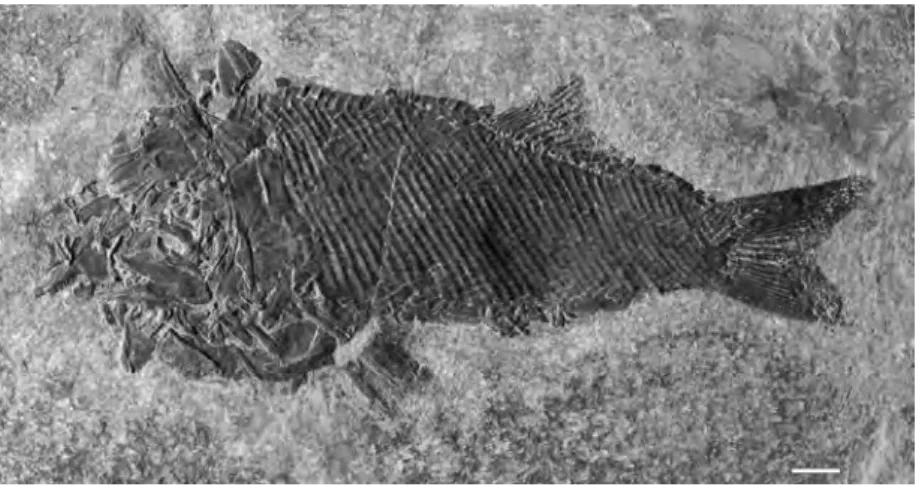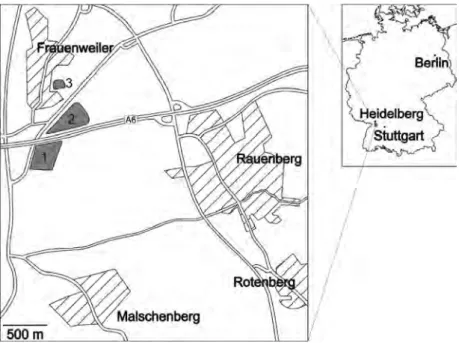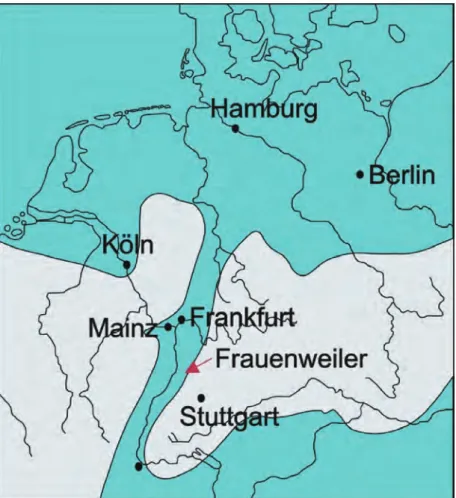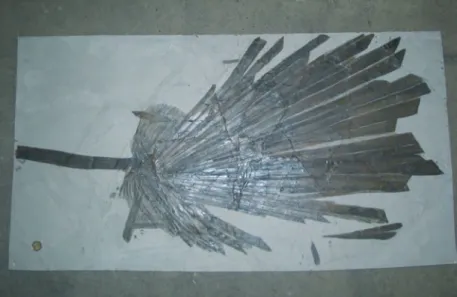actes 2009
bis
actes
2009 bis
5
th
International Symposium
on Lithographic Limestone
and Plattenkalk
Abstracts and Field Guides
Edited byJean-Paul Billon-Bruyat, Daniel Marty, Loïc Costeur, Christian A. Meyer & Basil Thüring
Actes 2009 bis
De la
Société juraSSienne D’émulation
année 2009
cent Douzième année
5
th
International Symposium
on Lithographic Limestone
and Plattenkalk
Naturhistorisches Museum Basel, switzerland
August 17
th-22
nd, 2009
Publié grâce au soutien financier de PaléoJura, Office de la culture, Porrentruy
Soutien administratif d’antoinette Hitz (naturhistorisches museum Basel) Soutien pour la relecture de catherine Friedli
(office de la culture, Section d’archéologie et paléontologie, Porrentruy) Soutien pour la conception de la Société jurassienne d’emulation
tous droits réservés
tant pour le texte que pour les illustrations note du comité directeur
les opinions exprimées par les auteurs sont personnelles et n’engagent en rien ni la Société ni le comité directeur.
responsable des Actes: martin choffat
© 2009, Société jurassienne d’emulation 8, rue du Gravier, cH-2900 Porrentruy
www.sje.ch
imprimé par le centre d’impression le Pays, Porrentruy iSSn 1011-2820
We suggest to cite the abstracts or Field Guides as follows:
Seilacher, a. 2009: Biomats and preservation in lithographic limestones. in: Billon-Bruyat, j.-P., marty, D., costeur, l., meyer, c.a. & thüring, B. (eds.): 5th international Symposium on lithographic limestone and Plattenkalk.
naturhistorisches museum Basel, Switzerland. actes 2009 bis de la Société jurassienne d’emulation, Porrentruy, 78-79.
Contents
Preface
By christian a. meyer ... 11
Abstracts
amaral, c. & Brito, P.m.: the role of the crato Formation (aptian of the araripe Basin, ne Brazil) fish fauna in palaeoenvironmental inferences
...15
BauScH, W.m.: Geochemical and mineralogical evidence for very high sedimentation rates in plattenkalks ... 16
Billon-Bruyat, j.-P., marty, D. & Bocat, l.: tetrapods from the late jurassic lithographic limestones and Plattenkalke of Western europe: an updated comparative review ... 17
BriGGS, D.e.G.: molecular taphonomy (Keynote) ... 19
caVin, l.: Fossil lagerstätten: skewed images or exceptional opportunities for understanding the fossil fish record? ... 21
cHu, G., WeiSS, c. & KocH, r.: Plattenkalks of the middle cambrian; zhangxian Formation; W-china (lenticular, wavy textures caused by compaction) ... 23
eBert, m. & KÖlBl-eBert, m.: the Quarry of ettling, Bavaria – the new excavation site of the jura-museum eichstätt ... 25
Frey, e.: Flat flyers – pterosaurs in laminated limestone (Keynote) ... 26
Furrer, H.: the diet of the predator fish Saurichthys from two middle triassic Plattenkalk lagerstätten in the Swiss alps ... 30
GaillarD, c.: a giant limulid trackway from the lithographic limestones of cerin (upper Kimmeridgian, France) ... 32
GierScH, S., Frey, e., iFrim, c., StinneSBecK, W.& GonzÁleS-GonzÁleS, a.H.: late cretaceous open marine Plattenkalk localities in northeastern mexico – characteristics of the fossil fish assemblages ... 34
HauG, c., HauG, j.t., maaS, a. & WaloSzeK, D.: new discoveries of mantis shrimps (Stomatopoda, crustacea) in lithographic limestones from Solnhofen and lebanon ... 36
HauG, j.t., HauG, c., maaS, a. & WaloSzeK, D.: reconstructing on-togenetic sequences of fossil crustacea from the Solnhofen lithographic limestones ... 38
HeSS, H.: life and Death of Saccocoma – Functional morphology, feeding and taphonomy of the most common Plattenkalk fossil ... 40
iFrim, c. & StinneSBecK, W.: a palaeoenvironmental model for the formation of mexican cenomanian-turonian (late cretaceous) open marine Plattenkalk ... 42
iFrim, c. & StinneSBecK, W.: inoceramids: environmental recorders of conditions of Plattenkalk formation ... 44
inieSto, m., lóPez-arcHilla, a.i., BuScalioni, a.D., PeñalVer, e., FreGenal-martínez, m.a., Guerrero, m.c.: experimental
simulation of initial stages of fossilization by bacterial sealing – implica-tions for the formation of las Hoyas Konservat-lagerstätte (lower cretaceous, iberian ranges, Spain) ... 46
joyce, W.G.: Fossil turtles from the late jurassic of europe (Keynote) ... 48
KluG, S.: Synechodontiformes, a largely disregarded group of early modern sharks in the jurassic ... 50
KriWet, j.: a revision of cow Sharks (chondrichthyes, Hexanchiformes) from the jurassic of europe ... 52
leFort, a., latHuilière, B., & Huault, V.: the oxfordian/Kim-meridgian boundary in the eastern and southern parts of the Paris Basin: comparison of two mudstone formations: Calcaire à astartes and Calcaires
lités supérieurs ... 54 marty, D. & Pacton, m.: Formation and preservation of late jurassic
dinosaur track-bearing tidal-flat laminites (canton jura, nW Switzerland) through microbial mats ... 56
mennecart, B. & BecKer,D.: Palaeobiology of Iberomeryx minor (mammalia, artiodactyla) from the lithographic limestone of Soulce (early oligocene, jura, Switzerland) ... 59
micKlicH, n.: the fish fauna of Frauenweiler clay pit (oligocene, rupelian; Baden-Württemberg, S Germany): an updated review in special conside-ration of new records ... 61
mÜller, m.K.: the fish fauna of the Solothurn turtle limestone ... 63
PaPazzoni, c.a. & treViSani, e.: relationships between the Pesciara di Bolca and the monte Postale Fossil-Lagerstätten (lessini mts., northern italy) ... 65
Paratte, G., marty, D., loViS, c., jacQuemet, m., HuG, W.a., iBerG, a., oriet, a., Denier, c., & miHajloVic, D.: methodology of systematic excavation and documentation of dinosaur tracksites along the transjurane highway (canton jura, nW Switzerland) ... 67
Peyer, K., KunDrÁt, m. & allain, r.: the history and future of the upper jurassic lithographic limestone quarry of canjuers, France and its fossils ... 69
ScHWeiGert, G. & Dietl, G.: ammonites from the nusplingen litho-graphic limestone (upper Kimmeridgian, SW Germany): what they tell us about their palaeobiology... 76
SeilacHer, a.: Biomats and preservation in lithographic limestones (Keynote) ... 78
StocKar, r.: the middle triassic cassina beds – First results from a new excavation in the monte San Giorgio uneSco WHl site (Switzerland)
... 80
field guides
Frey, e. & monninGer, S.: the Kraichgau caribbean – Field guide to the clay pit unterfeld near Frauenweiler and rauenberg, rupelian, early oligocene ... 85
marty, D. & Billon-Bruyat, j.-P.: Field-trip to the excavations in the late jurassic along the future transjurane highway near Porrentruy (canton jura, nW Switzerland): dinosaur tracks, marine vertebrates and invertebrates ... 94
meyer, c.a. & tHÜrinG, S.: late jurassic marginal marine ecosystems of the Southern jura mountains ... 130
Preface
Dear participants,
Following the former editions (lyon, 1991; cuenca, 1995; Bergamo, 1999; eichstätt/Solnhofen, 2005), we are pleased to welcome you to the 5th international Symposium on lithographic limestone and Plattenkalk
at the natural History museum in Basel. this meeting is jointly organized by the Basel natural History museum (christian a. meyer, Basil thüring, loïc costeur, antoinette Hitz) and the scientific staff of the Palaeontology a16 in Porrentruy (jean-Paul Billon-Bruyat, Daniel marty); the
Naturmuseum Solothurn (Silvan thüring) and the Staatliches Museum für Naturkunde Karlsruhe (Dino Frey, Stefanie monninger) are involved
in the organization of the field-trips.
We are very happy that Dolf Seilacher accepted to be a keynote speaker, he who started the famous research initiative “Sonderforschungsbereich 53” on palaeoecology and Fossil lagerstätten in tübingen back in the 80ties. Furthermore, also his colleague from yale Derek Briggs, who is an expert in modern molecular taphonomy, accepted to make a keynote contribution. another “yale” researcher (now in tübingen), Walter joyce, a junior scientist with a major interest in fossil turtles, is joining the key-note speakers. and, last but not least, Dino Frey, one of the leading experts of flying reptiles otherwise known as pterosaurs, will join us for the con-ference. all have one thing in common, they are all enthusiastic palaeon-tologists somehow related to Dolf’s hometown tübingen, where the major revival of the lithographic limestone and Black Shale research took place.
the present volume contains abstracts of oral presentations and posters that span the entire focus of research. From geochemical evidence on sedi-mentation rates in lithographic limestones or new and exciting discoveries such as mantis shrimps or limulid and dinosaur trackways to palaeoenvi-ronmental models of fish lagerstätten.
Frauenweiler (rhine Graben, near mannheim), famous for oligocene fishes, birds, and mammals; this site is currently threatened by destruction.
We would like to thank the canton jura and the Société jurassienne
d’Emulation for financing and publishing the abstracts and Field Guides
volume, and the commission of the Swiss Palaeontological memoirs for supporting the invitations of the keynote speakers and the supplemen-tary issue (proceedings volume) in the Swiss journal of Geosciences. We wish to express our gratitude to the international association of Sedimentologists (iaS) for sponsoring student travel grants. also, the support of the Swiss Palaeontological Society (SPS), the international Palaeontological Society (iPa), and the european association of Vertebrate Palaeontologists (eaVP) is greatly acknowledged.
i myself remember well the 1991 meeting in lyon, with a splendid field-trip to the lithographic limestone quarry in cerin under the hot sun, followed by a delicious and opulent lunch under white tents with tasty French wines. i hope that all of you will enjoy the scientific meeting as well as the field-trips and the exchange between old friends and new scientific contacts.
on behalf of the organizing committee
The role of the Crato Formation
(Aptian of the Araripe Basin, NE Brazil)
fish fauna in palaeoenvironmental
inferences
Cesar AmArAl
1& Paulo m. Brito
21Departamento de estratigrafia e Paleontologia, Faculdade de Geologia, universidade do
estado do rio de janeiro, São Francisco Xavier 524, maracanã 20559-900, rj, Brazil (crlama-ral@yahoo.com.br)
2Departamento de zoologia, instituto de Biologia, universidade do estado do rio de
janeiro, São Francisco Xavier 524, maracanã 20559-900, rj, Brazil
the crato Formation is known worldwide for the exceptional preserva-tion of its fossils and for its diverse assemblage, representing one of the richest Gondwanan Konservat lagerstätte. With about 200 nominal species described (including plants, invertebrates and vertebrates), the fossiliferous limestones of the crato Formation (nova olinda member) exhibit an abundant fish fauna dominated by the small gonorynchiform
Dastilbe crandalli.
the nova olinda member of the crato Formation is considered as a lagoonal system with a stratified water body formed by a well-mixed and complex epiliminion with probably fluctuating salinity and a stagnant, anoxic, and hypersaline hypolimnion, suggested by the absence of bot-tom-dwelling organisms and by parameters such as the occurrence of biomarker molecules and salt pseudomorphs. moreover, the influence of surrounding drainage contributing to this complex epilimnion seems to be evident when the fish fauna is considered. certain taxa do appear to be marine such as the new vidalamiin amiiform Cratoamia longidorsalis and the surface-living Vinctifer and Cladocyclus, both common in the nodules of the younger Santana Formation and known in other formations associ-ated with typical marine taxa.
Geochemical and mineralogical
evidence for very high sedimentation
rates in plattenkalks
Walter m. BAUSCH
Fau erlangen-nürnberg, Geozentrum nordbayern, Fachgruppe Paläoumwelt, loewenichstr. 28, 91054 erlangen, Germany
two essential differences have been found between plattenkalks and (normal) bedded limestones. a geochemical contrast consists in different ree spectra of the two limestone facies. the spectra of plattenkalk resemble those of marine claystones (proven on the French locations cerin and montdardier, as well as on two Franconian sites, e.g. Solnhofen). the spectra of bedded limestones, however, are quite another type and are similar to seawater (Bausch et al. 2008). a mineralogical contrast is evi-dent in the occurrence resp. absence of authigenic potassium feldspars. they can occur in relative pure bedded limestones; there they may form the bulk of the silt fraction in the insoluble residues (möderl 2000). Plattenkalks very often exhibit comparable purity around 1% of insolu-bles), but they don’t contain authigenic feldspars at all.
Both features might be explained by strongly different sedimentation rates. there are good reasons to estimate the sedimentation rates of the bed-ded limestones used in this study (upper oxfordian, Franconia) in the range of 1 cm/ky. on the other hand, the rates in Solnhofen plattenkalk are surely higher by the factor 10, maybe by the factor 20-30. in the case of (normal) bedded limestones there was time enough to equilibrate (more or less) the ree contents with seawater, and to form authigenic potassium feldspar (in a long term diagenetic process). if the plattenkalks sedimentation happened so rapidly that the ree spectrum of the detrital clay input was preserved, the authigenic feldspar formation could not be realized.
references
Bausch, W.m., Dulski, P. & möller, P. 2008: Platten- und Bankkalke: unterschiedliche See-Verteilungsmuster in nicht-karbonatischen rückständen und ihre Deutung. erlanger Beiträge zur Petrographischen mineralogie 18, 83-96.
möderl, t. 2000: charakterisierung verschiedener Karbonatssequenzen der Fränkischen alb (malm) – Quantitative Phasenanalyse der rückstandsilte. Dissertation erlangen, 162 pp.
Tetrapods from the Late Jurassic
lithographic limestones and
Plattenkalke of Western Europe:
an updated comparative review
Jean-Paul BilloN-BrUYAt, Daniel mArtY & loïc BoCAt
Palaeontology a16, Section d’archéologie et paléontologie, office de la culture, république et canton du jura, Hôtel des Halles, P.o. Box 64, 2900 Porrentruy 2, Switzerland (jean-paul. billon@palaeojura.ch)
tetrapods from the late jurassic (Kimmeridgian–tithonian) litho-graphic limestones and Plattenkalke of Western europe have been depos-ited in protected costal marine environments of shallow carbonate plat-forms, on the northern margin of the tethys. these marine, costal marine and continental tetrapods have been in the focus of many detailed studies (e.g., the pterosaurs, the bird Archaeopteryx). nonetheless, comparisons of the tetrapod assemblages at the regional (intracontinental) scale of Western europe have attracted little attention, even though the excellent combination of a high-resolution stratigraphical frame and the abundance and exceptional preservation of the fossil material from this region offers a great potential in this regard. as noticed earlier by Broin et al. (1991) and Buffetaut (1994), the faunal resemblances (sometimes at the genus or species level) between sites of Franconia (Germany), cerin and canjuers (France) suggest that they belonged to a same biogeographical province. the widespread distribution of some small to medium-sized terrestrial tetrapods (e.g., the sphenodontid Homoeosaurus, atoposaurid crocodil-ians, the theropod dinosaur Compsognathus) indicates that land connec-tions have existed throughout the region.
Buffetaut (1994) published a first descriptive study, mainly at the major group level, including the late jurassic assemblages of Franconia, cerin, and canjuers. He concluded to important resemblances and striking dif-ferences, the latter being explainable by different collecting histories,
evidence, suggesting that the assemblages indicate balanced insular fau-nas. in addition, he attempted a quantitative study (cluster analysis, sev-eral similarity indices, uPGma method) at the family level, showing that these communities are related but not as similar as previously thought.
Here, we report an update of this phenetic analysis, including the assemblage of the lithographic limestones of nuspligen (Kimmeridgian, Germany), new specimens from Porrentruy (excavations in progress) and by testing the cluster analysis at the genus level. it comes out that the com-parison is somewhat skewed by taxonomic problems. even if the taxa chosen are assumed to be monophyletic, some groups need to be revised, at the genus and even at the family level (e.g., the turtles of the family “Plesiochelyidae”; see joyce 2007). the resulting dendrograms confirm two major clusters, grouping the assemblages of “Franconia, cerin, and canjuers” and “Porrentruy and Solothurn” (a Swiss group). nusplingen and crayssac assemblages generally fall outside these two major clusters. at this time, the dendrograms seem to reflect more the different biases affecting the presence/absence of taxa than obvious fine-scale tetrapod palaeobiogeographic relationships.
references
Billon-Bruyat, j.-P. 2005: comparison of the tetrapod assemblages from the late jurassic Plattenkalk deposits of Western europe. 4th international Symposium on lithographic
limestone and Plattenkalk. eichstätt (Germany). zitteliana B26, p. 9.
Broin, F. de, Barta-calmus, S., Bauvais, l., camoin, G., Dejax, j., Gayet, m., michard, j.-G., olivaux, t., roman, j., Sigogneau-russell, D., taquet, P. & Wenz, S. 1991: Paléobiogéographie de la téthys: apports de la paléontologie à la localisation des rivages, des aires émergées et des plates-formes au jurassique et au crétacé. Bulletin de la Société Géologique de France 162, 13-26.
Buffetaut, e. 1994: tetrapods from the late jurassic and early cretaceous lithographic limestones of europe: a comparative review. Geobios mS 16, 259-265.
joyce, W.G. 2007: Phylogenetic relationships of mesozoic turtles. Bulletin of the Peabody museum of natural History 48, 3-102.
Molecular taphonomy
Derek E.G. BriGGS
Department of Geology and Geophysics and Peabody museum of natural History, yale university, Po Box 208109, new Haven, ct 06520, uSa (derek.briggs@yale.edu)
Keynote
the preservation of organic tissues in fossils involves the molecular transformation of biomolecules to geomolecules by processes similar to those that generate sedimentary organic matter and ultimately result in the formation of kerogen. Such diagenesis can be investigated by analys-ing fossils and undertakanalys-ing laboratory experiments involvanalys-ing decay and thermal maturation.
recent results (Gaines et al. 2008) have shown that the preservation of carbonaceous material, albeit transformed from its original composition, is the primary explanation for the famous Burgess Shale type deposits of the cambrian. exceptional preservations are more abundant in the cambrian than in younger rocks. the key to understanding the preserva-tion of organic materials, however, lies in younger deposits. Previous investigations of molecular taphonomy focused on how long particular macromolecules survive in the rock record. traces of chitin, for example, are present in beetle cuticles from oligocene oil shales (Stankiewicz et al. 1997), but could not be detected in older strata.
While the length of time that biomolecules survive is an important question, more interesting is understanding how organic material is trans-formed diagenetically, what components are involved, and how soon this process starts. chitin can be detected in tertiary fossils but even these geologically young deposits show diagenetic change involving the forma-tion of resistant long-chain aliphatic macromolecules. experiments have been carried out on arthropods that occur as fossils (shrimp, scorpion and cockroach) to discover how the chitin-protein and associated lipids in the cuticle decay (Gupta et al. 2009a). the cockroach and scorpion cuticle
components are incorporated that can give rise to the aliphatic-rich com-position of organic fossils. the process starts within weeks.
How soon alteration begins is one question – another is which original components are necessary to form the long chain diagenetic product. chemical analysis of leaves of modern Metasequoia (the dawn redwood), for example, showed that they consist of the cutin, lignin and polysaccha-rides but contain no resistant aliphatic constituent (Gupta et al. 2009b). analysis of Metasequoia leaves that degraded naturally in ponds showed that internal tissues were lost while the cuticle tended to survive: lignin and cellulose decayed more rapidly than cutin. thermal maturation exper-iments on cutin in the laboratory produced an aliphatic polymer of rela-tively short chain length. Fossil Metasequoia leaves from the eocene of Washington State, on the other hand, showed a significant aliphatic com-ponent with chain length up to c23. maturation of living Metasequoia leaves likewise generated longer chain lengths, presumably due to the incorporation of leaf waxes. maturation experiments on arthropods have shown that soluble lipids such as fatty acids are critical to the generation of the resistant aliphatic macromolecules that characterize fossils (Gupta et al. 2006).
the composition of different organic fossils within the same deposit reflects their original chemistry – fish scales, arthropods and plants from the cretaceous las Hoyas Formation of Spain are distinct (Gupta et al. 2008). all these fossils, however, are dominated by an aliphatic macro-molecular component indicating a similar mode of diagenesis – the polym-erization of labile molecules that were present in the original organism.
references
Gaines, r.r., Briggs, D.e.G. & zhao, y.-l. 2008: cambrian Burgess Shale-type deposits share a common mode of fossilization. Geology 36, 755-758.
Gupta, n.S., michels, r., Briggs, D.e.G., evershed, r.P. & Pancost, r.D. 2006: the organic preservation of fossil arthropods: an experimental study. Proceedings of the royal Society, london B 273, 2777-2783.
Gupta, n.S., cambra-moo, o., Briggs, D.e.G., love, G.D., Fregenal-martinez, m.a. & Summons, r.e. 2008: molecular taphonomy of macrofossils from the cretaceous las Hoyas Formation, Spain. cretaceous research 29, 1-8.
Gupta, n.S., cody, G.D., tetlie, o.e., Briggs, D.e.G. & Summons, r.e. 2009a: rapid incor-poration of lipids into macromolecules during experimental decay of invertebrates: initiation of geopolymer formation. organic Geochemistry 40, 589-594.
Gupta, n.S., yang, H., leng, Q., Briggs, D.e.G., cody, G.D. & Summons, r.e. 2009b: Diagenesis of plant biopolymers: decay and macromolecular preservation of Metasequoia. organic Geochemistry, in press.
Stankiewicz, B.a., Briggs, D.e.G., evershed, r.P., Flannery, m.B. & Wuttke, m. 1997: Preservation of chitin in 25 million-year-old fossils. Science 276, 1541-1543.
Fossil Lagerstätten: skewed images or
exceptional opportunities for
understanding the fossil fish record?
lionel CAViN
Département de géologie et paléontologie, muséum d’histoire naturelle de la Ville de Genève, cP 6434, 1211 Geneva 6, Switzerland (lionel.cavin@ville-ge.ch)
Fossil lagerstätten represent extraordinary windows in the past for studying history of life. the fossil record of the ray-finned fishes (actin-opterygians) from the late jurassic to the terminal cretaceous shows bursts of diversity related to the occurrence of lagerstätten, in particular the late jurassic lithographic limestone of Southern Germany and the early late cretaceous plattenkalk of lebanon. these peaks of diversity, however, are difficult to interpret because diversity curves based on com-pilation of fossil occurrences do not directly mirror biological diversity. in fossil lagerstätten the diversity is overestimated compared to other time intervals because the rate of fossilization of the organisms is propor-tionally high. this bias questions a direct biological interpretation of these peaks.
a way to distinguish sampling patterns from biologically driven pat-terns is to look at the phylogenetic relationships of the contemporaneous taxa composing the curves of diversity. evolutionary distance between taxa composing an assemblage can be expressed as the average ghost lin-eage duration (aGD) of these taxa. looking at the variation of the aGD through successive intervals of time allow distinguishing peaks caused by genuine biological radiations from peaks caused by sampling biases. When applied to the late jurassic and to the early late cretaceous peaks of diversity, aGD in both time intervals show different patterns. the aGD
that occurred at that time (although a “lagerstätten effect” had probably enhanced the peak).
Qualitative studies of the taxonomic composition of fossiliferous assemblages is a promising tool to detect the signal of a genuine biologi-cal radiation in the fossil record, even if this signal is hidden by a biased curve of diversity caused by a “lagerstätten effect”.
Plattenkalks of the Middle Cambrian;
Zhangxian Formation; W-China
(lenticular, wavy textures caused by
compaction)
Guangzehn CHU, Christian WEiSS & roman KoCH
Geozentrum nordbayern, institute of Paleontology, loewenichstr. 28, 91054 erlangen, Germany (rkoch@pal.uni-erlangen.de).
remarkable bedding features occur in middle cambrian Plattenkalks from W-china. at the first glace parallel beds of up to 5 cm thickness might indicate horizontal bedding, alternation of marls and thin limestone beds. But a closer look reveals that the Plattenkalks have undergone a complex sedimentary and diagenetic compaction, pressure solution his-tory. the Plattenkalks are characterized by wavy, stylolitic boundaries between single beds revealing different thickness of clay accumulation (Fig. 1). most characteristic are the crosscutting relationships of stylolites, which only locally allow horizontal parallel surfaces of the beds. most obvious is the lateral pinch out of beds with a maximum of 5 cm thickness within some centimetres.
the middle and lower upper cambrian sequences consist of shallow water carbonates predominantly deposited in an outer to inner ramp envi-ronment. there occur mudrocks, storm deposits in the lower part and oolitic grainstones and tidal-flat lime mudstones in the upper part. the different facies types now are bordered by stylolites seams and show an intimate inferfingering, commonly indenting fabric in which the primary sedimentary boundaries can be nevertheless well recognized.
a complex sedimentary, diagenetic and compactional model is dis-cussed to reveal the development of these extraordinary Plattenkalks.
figure 1: characteristic appearance of the middle cambrian Plattenkalks with common
pinch-out of beds (maximum thickness = 5 cm) within a lateral distance of some centimetres to deci-metres. Parallel boundaries of single beds occur rarely. this results in the characteristic wavy texture of the Plattenkalks.
The Quarry of Ettling, Bavaria – the new
excavation site of the Jura-Museum
Eichstätt
martin EBErt & martina KÖlBl-EBErt
jura-museum eichstätt, Willibaldsburg, 85072 eichstätt, Germany (Koelbl-ebert@jura-museum.de)
Since summer 2007, the jura-museum eichstätt is undertaking a sci-entific excavation in the Plattenkalk quarry of ettling (markt Pförring), some 15 km south of Schamhaupten (ebert & Kölbl-ebert 2008b). So far, the excavation provided an immensely interesting spectrum of fossil fishes with many endemic species usually of exceptionally good preservation. these fishes are early teleosts as well as semionotids and other ganoid-scaled fish.
the ettling quarry is part of a larger Plattenkalk basin, the exact mor-phology of which is unknown. the time is upper jurassic, possibly upper Kimmeridgian or lower tithonian. ammonites, however, are very rare and badly preserved, and so exact dating has been impossible.
So far, the excavation documented 22 fish species, among them at least nine new species and a sparse accompanying fauna of some arthropods, brachiopods, molluscs, echinoderms, one juvenile turtle and possibly hydromedusae. additionally, there are some plant fragments, isolated dragonfly wings and an ichnofauna. So far, there are no squid.
the food chains of ettling seem to have been dominated by fish. the exceptional preservation also of stomach content allows for a detailed investigation of this ecosystem (e.g., ebert & Kölbl-ebert 2008a).
references
ebert, m. & Kölbl-ebert, m. 2008a: räuber-Beute-Beziehungen bei Orthogonikleithrus
Flat flyers – pterosaurs in laminated
limestone
Eberhard FrEY
Staatliches museum für naturkunde Karlsruhe, Geowissenschaftliche abteilung, referat Paläontologie und evolutionsforschung, erbprinzenstr. 13, 76133 Karlsruhe, Germany (dino. frey@smnk.de)
Keynote
Being invited to a keynote lecture on pterosaurs in laminated limestone as a zoologist, i asked an expert geologist for the definition of “laminated limestone”. Here are some useful suggestions: “laminated limestones with pterosaurs… Hmmm”, “Solnhofen is not really a laminated lime-stone, but a plattenkalk”, or “crato is a laminated limestone. it is couplets of calcite (sometimes dolomitised) with organic matter” (expert, e-comm., 2009). With this profound information in hand, i decided to talk about pterosaurs from any fine grained deposit consisting of more ore less undis-turbed layers at millimetric scale. if the lamination is not of diagenetic origin, such sediments were mostly deposited under stagnant conditions in a variety of non-marine and marine environments and thus in general have an excellent fossilisation potential. From such laminated sediment the most spectacular fossils have been unearthed, amongst them ptero-saurs, the flying reptiles of the mesozoic.
Evolution and diversity
the time range of the pterosaur localities with laminated sediments spans from the late triassic (e.g. calcari de zorzino Formation near Bergamo, italy) yielding the earliest known pterosaurs into the late cretaceous (e.g. niobrara chalk, north america), where some of the latest pterosaurs were discovered. a variety of pterosaur localities with laminated sediments throughout the jurassic and early cretaceous provides direct evidence of pterosaurian evolution and temporal changes in pterosaurian diversity.
Palaeogeography
laminated sediments are distributed all over the word. this helps to reconstruct at least aspects of the palaeogeography of pterosaurs and indi-cate dispersion corridors or barriers. For the reconstruction of the
pterosaurian palaeogeography also those localities are of importance, where pterosaurs are exceedingly rare, e.g., the late jurassic “sublitho-graphic” Sannine limestone (i like it!) from lebanon or the huge late cretaceous laminated limestone of the muzquiz area, coahuila, mexico.
Palaeobiology and biomechanics
the preservation quality in some laminated sediments, e.g., the late jurassic Solnhofen Plattenkalk in Bavaria, southern Germany, the early cretaceous crato Formation, northeastern Brazil or the jehol Formation, early cretaceous, cina, is so brilliant that we now have information on the finest skeletal details and different soft tissue types of those flat fliers that the gate to their biology, physiology, locomotion and ontogeny is pushed open. Several deposits have yielded excellently preserved foot-prints confirming the pedal soft parts preserved in other localities. to date, pterosaurs are probably the best-known extinct vertebrates in the world and, due to their flight capabilities and the detailed knowledge of their flight apparatus, caught the interest of flight engineers and smart membrane manufacturers.
The oldest azhdarchoid pterosaur from
the Late Jurassic Solnhofen Limestone
(Blumenberg, Bavaria; Early Tithonian)
of Southern Germany
Eberhard FrEY
1& Christian A. mEYEr
21Staatliches museum für naturkunde, erbprinzenstrasse 13, 76113 Karlsruhe, Germany
(dino.frey@smnk.de)
2naturhistorisches museum, augustinergasse 2, 4001 Basel, Switzerland
Based on an almost complete three-dimensionally preserved skeleton, a new genus and species of an azhdarchoid pterosaur from the late jurassic Solnhofen limestone (early tithonian) of the eichstätt area (Bavaria, Germany) is described. the specimen is attributed to azdarchoidea due to its glenoid fossa level with the sternum, the shovel-like shape of the sternal plate, the wide furca of the coracoid, the meta-carpus being longer than radius and ulna, the femur being one third longer than the humerus, the femorotibial ratio, and the hammer-like shaped humerus among other diagnostic features. under uV-light, soft tissue preservation around the imprint of the head is preserved. it consists of tiny flakes interpreted as remains of the skin. the outline of the head imprint suggests the presence of a cranial crest. the new pterosaurs species is the oldest record of the family azhdarchidae und furthermore supports the eurasian origin of the group that includes the largest flying animal ever.
News about the diversity of coleoid
cephalopods from the Cenomanian
Plattenkalks of Lebanon
Dirk FUCHS
Freie universität Berlin, institute of Geological Sciences, malteserstr. 74-100, 12249 Berlin, Germany (drig@zedat.fu-berlin.de)
thanks to the digging activities of the family abi-Saad (Hâkel) and its scientific co-operation, the number of coleoid cephalopods that roamed the coastal waters of lebanon during cenomanian times is continuously increasing. in the past three years of research five new taxa have been recognised.
Glyphiteuthis abisaadiourum n. sp. Fuchs & Weis (in press) is a close
relative of Glyphiteuthis libanotica, a familiar member of the coleoid fauna in lebanon. the new form can be distinguished from Gl. libanotica by the presence of an obviously more slender gladius outline and by con-siderably longer arms. another (very rare) form, which has been neglected in the course of previous taxonomic confusions (“Palaeololigo sp.”), needs to be urgently re-described. a possible specimen of this poorly known form has been found in the collections of the museo civico di Storia naturale (milan). it exhibits a gladius that shows similarities to teudopseid genera Teudopsis, Palaeololigo and Glyphiteuthis. the most spectacular discoveries, however, are the records of Keuppia
hyperbola-ris, Keuppia levante and Styletoctopus annae. the extraordinarily
well-preserved specimens of these taxa represent the oldest known octopuses (Fuchs et al. 2009).
each of the new taxa will be presented and described from tip to toe (i.e., from suckers to fins).
The diet of the predator fish
Saurichthys from two Middle
Triassic Plattenkalk Lagerstätten
in the Swiss Alps
Heinz FUrrEr
Paläontologisches institut und museum der universität zürich, Karl Schmid-Str. 4, 8006 zürich, Switzerland (heinz.furrer@pim.uzh.ch)
the actinopterygian Saurichthys is a cosmopolitan fish, known from freshwater and marine deposits of early to late triassic age. Saurichthys was an important predator in the triassic seas, which represented together with aquatic reptiles as ichthyosaurs or sauropterygians the top of the food web. the long snout with its rows of conical teeth suggests feeding on swimming prey, however only little is known from literature. rieppel (1985: p. 53) described a specimen of S. macrocephalus from the middle triassic of monte San Giorgio (ticino), with a smaller specimen of S. curionii in the stomach area. recently prepared material from the same locality in the Southern alps and from the time equivalent Prosanto Formation in the eastern Swiss alps near Davos (Graubünden) include some exciting specimens of five different species of Saurichthys, yielding not fully digested prey in the mouth, throat or stomach.
Both localities in the Swiss alps have an outstanding quality of preservation, resembling lithographic limestone or Plattenkalk lagerstätten. at monte San Giorgio, 50 specimens of Saurichthys have been excavated bed by bed by a team of zürich university in 1970-1974 from the early ladinian cassina beds of the meride Formation (Furrer 2003). recently a medium sized specimen of S. curionii with a smaller specimen of the same species stuck in its snout was prepared carefully.
Since 1993 another 50 well-preserved specimens of Saurichthys belonging to five different species were excavated bed by bed from a fossil-rich level in the upper part of the Prosanto Formation from the eastern Swiss alps near Davos. new u-Pb ages of a volcanic ash layer from the same horizon allowed a precise radiometric dating of this fauna (240.91±0.26 ma, earliest ladinian; Furrer et al. 2008). two small specimens of S. costasquamosus and S.
paucitri-chus have nearly complete specimens of the small actinopterygian Habroichthys minimus in their stomach. another small sauropterygian (Neusticosaurus sp.)
is stuck in the throat of the largest specimen with a length of 100 cm (Saurichthys spec. nov.), proving hunting of small reptiles by this big fish.
as suggested by Furrer (2004), these fossils document the relationship between prey and predator in the food web of the middle triassic shallow seas (Fig. 1).
figure 1: a simplified food web of the middle triassic seas. the proved relationships between
prey and the actinopterygian Saurichthys are marked by bold arrows (modified from Furrer 2004).
references
Furrer, H. 2003: Der monte San Giorgio im Südtessin – Vom Berg der Saurier zur Fossil-lagerstätte internationaler Bedeutung. neujahrsblatt der naturforschenden Gesellschaft zürich 206, 64 pp.
Furrer, H. 2004: So kam der Fisch auf den Berg – eine Broschüre zur Sonderausstellung über die Fossilfunde am Ducan. Bündner natur-museum chur und Paläontologisches institut und museum der universität zürich, 32 pp.
A giant limulid trackway from the
lithographic limestones of Cerin
(Upper Kimmeridgian, France)
Christian GAillArD
université de lyon 1, cnrS, umr 5125 Paléoenvironnements et PaléobioSphère, 2, rue raphaël Dubois, 69622 Villeurbanne, France (christian.gaillard@univ-lyon1.fr)
a well-preserved large limulid trackway, three metres long, is described in the upper Kimmeridgian lithographic limestones of cerin (ain, France). it exhibits ten successive sets of imprints characterized by a pair of well-preserved four digitate main imprints (legs Vi named pushers) and a variable number (mostly three pairs) of straight thin intermediate imprints (legs iii to V).
the trackway is related to Kouphichnium lithographicum (oppel, 1862). it is unusually wide and was probably made by a very large adult (approximately 38 cm wide and 80 cm long by reference to the propor-tions of the modern Limulus polyphemus). the straightness of the track-way, the great repeat distance (stride), the length of series of leg imprints, their slight angle to mid-line, the well-marked pusher (= leg Vi) imprints and the absence of groove made by the telson all indicate a fast walking of a vigorous animal on the sea floor.
this walking trackway may be easily differentiated from other limulid traces illustrating crawling, ploughing and dying (mortichnia) trackways usually found in lithographic limestones or other deposits of the geologi-cal record. main characteristics of these different limulid trackways may be evidenced.
the occurrence of a living adult in the cerin restricted lagoon is prob-ably related to a brief period with an efficient communication with the open sea. this occurrence also could indicate either a passive introduction of the animal into the lagoon either a spawning behaviour.
figure 1: a pusher’s imprint (Vi) and two leg imprints (leg iii bifid and leg iV simple) of the
preceding set. the direction of locomotion is indicated by the arrow. Scale bar = 1 cm.
references
oppel, a. 1862: ueber Fährten im lithographishen Schiefer (ichnites lithographicus). Palaeontologische mitteilungen aus dem museum des Koeniglich Bayerischen Staates Stuttgart 1, 121-125.
Late Cretaceous open marine
Plattenkalk localities in northeastern
Mexico – Characteristics of the fossil
fish assemblages
Samuel GiErSCH
1, Eberhard FrEY
1,
Christina iFrim
2, Wolfgang StiNNESBECK
2& Arturo H. GoNZÁlES-GoNZÁlES
31Geowissenschaftliche abteilung, Staatliches museum für naturkunde, erbprinzenstr. 13,
76133 Karlsruhe, Germany (samuel.giersch@smnk.de)
2institut für Geowissenschaften, universität Heidelberg, im neuenheimer Feld 234, 69120
Heidelberg, Germany
3museo del Desierto, Prol. Pérez treviño 3745, centro metropolitano Parque las maravillas,
25015 Saltillo, coahuila, mexico
an increasing demand for building stones in the north east of mexico is presently producing a number of new quarries, particularly within the states of coahuila and nuevo león. as a result of this activity at least ten
Plattenkalk localities have been mapped over the last ten years and among
a diverse invertebrate fauna, fish are the most abundant vertebrates found within these fossil assemblages (Blanco et al. 2001; Stinnesbeck et al. 2005). a wide range of preservation types can be observed from speci-mens where mineralization has destroyed the original anatomical details to exceptionally preserved specimens showing soft parts and even colour patterns within the squamation.
the abundance of fossils varies widely within the Plattenkalk deposits depending on both locality and stratum. the richest locality in terms of fossil abundance within the region is located in the early turonian depos-its at Vallecillo where in the past ten years several hundreds of fish speci-mens were collected during quarrying and scientific excavations (Blanco-Piñon 2003; ifrim et al. 2005; ifrim 2006). the high number of specimens represents an assemblage of low taxonomic diversity. the analysis of size variation within a taxon and the investigation on stomach content clarifies several aspects of the palaeoecology of the fauna.
taxonomical studies of the different fish assemblages discovered in the region show a palaeobiogeographical relationship with those of the
Western interior Seaway of the north american continent as well as with the Western and central tethys and South atlantic (Giersch et al. 2008). the current dataset already provides new insights into the mid cretaceous fish radiation in this region. the wide regional occurrence of the mexican
Plattenkalk deposits and their geological age range within the early late
cretaceous allows for a more detailed study into the development of the fish assemblages in the mesozoic Gulf of mexico.
references
Blanco, A., Stinnesbeck, W., López-Oliva, J.-G., Frey, E., Adatte, T., Gonzáles, A.H. 2001: Vallecillo, Nuevo León: una nueva localidad fosilífera del Cretácico Tardío en el noreste de México. Revista Mexicana de Ciencias Geológicas 18, 196-199.
Blanco-Piñon, A. 2003: Peces fósiles de la Formación Agua Nueva (Turoniano) en el Municipio de Vallecillo, Nuevo León, NE-México. Unpublished PhD thesis, Universidad Autónoma de Nuevo León, 345 pp.
Giersch, S., Frey, E., Stinnesbeck, W. & González, A.H. 2008: Fossil fish assemblages of northeastern Mexico: New Evidence of Mid Cretaceous actinopterygian radiation. 6th
interna-tional meeting of the European Association of Vertebrate Palaeontologists, Volume of Abstracts, Museum Spisa, Spisska Nova Vez, Slovakia.
Ifrim, C. 2006: The Fossil Lagerstätte at Vallecillo, North-Eastern Mexico: Pelagic
Plattenkalks related to Cenomanian-Turonian Boundary Anoxia. Unpublished PhD thesis,
University of Karlsruhe, ix+151 pp.
Ifrim, C., Frey, E., Stinnesbeck, W., Buchy, M.-C., González González, A.H., López Oliva, J.-G. 2005: Fish assemblage in Lower Turonian carbonates at Vallecillo, N.L., México. Paleos Antiguo 1, 43-51.
Stinnesbeck, W., Ifrim, C., Schmidt, H., Rindfleisch, A., Buchy, M.-C., Frey, E., Gonzáles, A.H., Vega, F.J., Cavin, L., Keller, G. and Smith, K. 2005: A new lithographic limestone deposit in the Upper Cretaceous Austin Group at El Rosario, county of Múzquiz, Coahuila, northeast-ern Mexico. Revista Mexicana de Ciencias Geológicas, v. 22, núm. 3, 401-418.
New discoveries of mantis shrimps
(Stomatopoda, Crustacea)
in lithographic limestones from
Solnhofen and Lebanon
Carolin HAUG, Joachim t. HAUG,
Andreas mAAS & Dieter WAloSZEK
Biosystematic Documentation, university of ulm, Helmholtzstr. 20, 89081 ulm, Germany (carolin.haug@uni-ulm.de)
the (sub)lithographic limestones of Solnhofen and lebanon are rich in crustacean fossils. the mantis shrimps (Stomatopoda), the sister group to all remaining eumalacostraca, are well-represented. While stomatopod specimens from the Solnhofen lithographic limestones are long known to fluoresce when exposed to uV light, fossils from lebanon and even from some areas close to Solnhofen, e.g., from zandt, do not in general fluo-resce under the same wavelengths. We found, however, that these fossils exhibit good fluorescence when exposed to green light. this highlights even tiny structures invisible under normal light. as most of the speci-mens we studied were just a few millimetres long, we used a fluorescence microscope with 50 or 100 times magnification to document the speci-mens in high detail. Several images in different focal planes in z-axis need to be taken, as not all areas are in focus on a single image. these image stacks are then fused (= image fusion). moreover, it is necessary to take several of these image stacks in x- and y-axis not to miss any structure and to combine the fused images (= image stitching). this results in a high-resolution compound image, which forms the base for further inves-tigations. Besides many finds of fossil adult stomatopods, also fossil lar-vae have been reported, but all specimens presumed as such turned out to be thylacocephala, an arthropod group of yet unknown systematic affinity.
We report here (Fig. 1; Haug et al. 2008) the first definite find of a fos-sil stomatopod larva from Schernfeld near eichstätt (lower tithonian, eichstätt Formation, Solnhofen lithographic limestones). this specimen can be assigned to Stomatopoda because of its tri-flagellate antennulae and raptorial appendages. other characters like the rostrum and the uro-pods indicate a larval state, confirmed by comparison to larval stages of recent species. even more larval specimens discovered thereafter
are currently under investigation. up to now, only the most posterior appendages of fossil mantis shrimps, i.e., uropods and pleopods, were known well enough to be useful morphological features in phylogenetic studies. although Kunth (1870) mentioned one specimen with at least partly preserved raptorial appendages, he did not document these append-ages by any drawing, and no details on this issue were published up to date. During our studies we found several specimens of apparently dif-ferent species of stomatopods with well-preserved raptorial appendages. these data shed new light on the phylogeny within Stomatopoda and ena-bled us to create a reasonable evolutionary scenario of this taxon.
figure 1: 3D model of the first true fossil stomatopod larva (Sculda sp.).
references
Haug, j.t., Haug, c. & ehrlich, m. 2008: First fossil stomatopod larva (arthropoda: crustacea) and a new way of documenting Solnhofen fossils. Palaeodiversity 1, 103-109.
Kunth, a. 1870: ueber wenig bekannte crustaceen von Solenhofen. zeitschrift der Deutschen Geologischen Gesellschaft 22, 771-790.
Reconstructing ontogenetic sequences
of fossil Crustacea from the Solnhofen
lithographic limestones
Joachim t. HAUG, Carolin HAUG,
Andreas mAAS & Dieter WAloSZEK
Biosystematic Documentation, university of ulm, Helmholtzstr. 20, 89081 ulm, Germany (joachim.haug@uni-ulm.de)
Developmental palaeobiology, i.e., the reconstruction of the ontogeny of fossil species, is a well-established field of research for example in mollusca. For arthropods this field is mainly limited to the stiffened dor-sal parts of trilobites and ostracodes. However, the reconstruction of the morphogenesis of structures comparable to that in recent species is pos-sible for fossil arthropods. yet, it requires a special mode of fossil preser-vation, in which not only details of the ventral surface, mainly the append-ages, are preserved. also different developmental stages have to be available. two Palaeozoic lagerstätten, which yielded 3D preservation of the bodies and ontogenetic data are the cambrian “orsten”-type sites (maas et al. 2006) and the Devonian rhynie chert. these lagerstätten lack until now any evidence on malacostraca. the upper jurassic lithographic limestones of Solnhofen, on the other hand, are one of the best sites for malacostracan fossils, showing detailed preservation of adult and larval specimens though flattened (e.g., Polz 1972). yet, research on fossil malacostraca from Solnhofen focused mainly on large specimens. to study also small specimens, we have adopted methods from other fields, such as composite fluorescence imaging (Haug et al. 2008). We also acquired the general composite imaging method for investigating smallest specimens with just a few millimetres in length. With these methods it was possible for us to identify a number of larval stomatopods. one of these could be affiliated with a juvenile stage to a new species. Developmental patterns could also be identified. one example is the mor-phogenetic change of the tail fan, i.e., uropods and pleotelson, of Stomatopoda from the juvenile to the adult state (Fig. 1). Such findings are important for recognising morphological differences not as interspe-cific but between ontogenetic stages. Based on these results the approach of developmental palaeobiology should be used to search for juvenile specimens misidentified as new species. also evolutionary scenarios be nefit from applying developmental palaeobiology. We documented, for
example, a drastic functional change of the antenna in the malacostracan taxon achelata. this helped to identify heterochronic events, i.e., evolu-tionary changes in ontogeny, in the evoluevolu-tionary lineage of Scyllaridae.
figure 1: 3D model of Sculda sp.; left: juvenile tail fan, right: adult tail fan.
references
Haug, j.t., Haug, c. & ehrlich, m. 2008: First fossil stomatopod larva and a new way of documenting Solnhofen material. Palaeodiversity 1, 103-109.
maas, a., Braun, a., Dong, X., Donoghue, P.c.j., müller, K.j., olempska, e., repetski, j.e., Siveter, D.j., Stein, m. & Waloszek, D. 2006: the “orsten” – more than a cambrian Konservat-lagerstätte yielding exceptional preservation. Palaeoworld 15, 266-282.
Polz, H. 1972: entwicklungsstadien bei fossilen Phyllosomen (Form a) aus den Solnhofener Plattenkalken. neues jahrbuch für Geologie und Paläontologie monatshefte 11, 678-689.
Life and Death of Saccocoma –
Functional morphology, feeding and
taphonomy of the most common
Plattenkalk fossil
Hans HESS
naturhistorisches museum Basel, augustinergasse 2, 4001 Basel, Switzerland (hans.hess@ bluewin.ch)
the morphology of the stalkless Saccocoma tenella is unique among crinoids. it is characterized by an extremely light skeleton with dish-like lateral wings on the proximal brachials and peculiar paired vertical proc-esses or baffles on the more distal brachials. the arms are heavily branched. While the lateral dishes obviously are involved in the sinking process the role of the vertical processes has remained unanswered. most authors assumed Saccocoma to have been planktonic or pelagic but milsom (1994) and manni et al. (1997) advocated a benthic lifestyle. this is rejected for morphological, environmental and taphonomic reasons.
Saccocoma fed in the oxygenated layer of the water column, most
prob-ably on coccolithophorids. How exactly Saccocoma fed has so far not been explained in a satisfactory way. Pelagic crinoids have to move rela-tive to the water to catch food. Seilacher & Hauff (2004) proposed a “snap swimming” model for Saccocoma tenella. they considered the commonly observed coiling of the arms not as a taphonomic artifact but as a frozen snapshot of swimming activity. in this model the vertical processes were connected by muscles that, upon contraction, loaded the elastic aboral ligament spring. upon release of the energy thus stored the arm snapped back in an active stroke. However, there is no evidence that the processes were connected by muscles and proper coiling would have been impeded by the side branches. it also seems highly unlikely that large numbers of
Saccocoma tenella were frozen in a swimming mode on the bedding
planes. a taphonomic explanation for the coiled arms, as already pro-posed by jaekel (1892), is, therefore, preferred. For swimming and food collection a “pulsating funnel” model is advocated. contraction of the adoral muscles in the proximal region flexed the arms inward so that a funnel was formed. as a result, the animal was sinking but this was slowed by increased drag from the wings. the middle region and especially the distal, branched region with weakly developed muscles presumably
were more horizontal, forming a filtration fan. upward movement of the fan allowed the animal to scoop plankton between the oral processes where the food grooves are situated. relaxation of the muscles caused elastic recoil of the antagonistic aboral ligaments in the power stroke. During this phase the downward-concave wings of the widened funnel acted as paddles, pushing the cup upward. in contrast, extant stalked cri-noids and comatulids form a filtration fan directed upstream; food parti-cles impinge on adhesive tube feet extended between the pinnules. a pre-requisite for the proposed model is that the animals floated with the cup directed downward. this is supported by the taphonomy.
references
jaekel, o. 1892: ueber Plicatocriniden, Hyocrinus und Saccocoma. z. Deutsch. geol. Ges. 44, 619-696.
manni, r. nicosia, u. & tagliacozzo, l. 1997: Saccocoma, a normal benthonic stemless crinoid: an opportunistic reply within mud-dominated facies. Palaeopelagos 7, 121-132.
milsom, c.V. 1994: Saccocoma: a benthic crinoid from the jurassic Solnhofen limestone, Germany. Palaeontology 37, 121-129.
Seilacher, a. & Hauff, r.B. 2004: constructional morphology of pelagic crinoids. Palaios 19, 3-16.
A palaeoenvironmental model
for the formation of Mexican
Cenomanian-Turonian
(Late Cretaceous) open marine
Plattenkalk
Christina iFrim & Wolfgang StiNNESBECK
institut für Geowissenschaften, universität Heidelberg, im neuenheimer Feld 234, 69120 Heidelberg, Germany (cifrim@geos.uni-heidelberg.de)
the Vallecillo Plattenkalk is famous for its excellently preserved ver-tebrates, among them abundant fishes, but also mosasauroids and turtles (Buchy et al. 2005; ifrim et al. 2005; ifrim 2006; ifrim et al. 2008). the continuous fossil record allows for detailed biostratigraphic subdivision by ammonites, inoceramid bivalves and planktonic foraminifers, with the most complete early turonian record (ifrim & Stinnesbeck 2007, 2008).
the Vallecillo Platy limestone member is now known from four local-ities, which are up to 300 km apart. During the sea-level highstand of the early turonian, the submarine topography was smooth, and barriers that could inhibit the oceanic circulation, were absent. the “restricted-basin-model”, which can be applied to most Plattenkalk deposits hitherto known, is thus insufficient to explain the formation of Plattenkalk on the open shelf of the Gulf of mexico. the compilation of results from micro- and nannofacies analyses, and of geochemical, sedimentological, statistical and palaeoceanographic data allows for a reconstruction of the palaeoen-vironmental conditions under which the Vallecillo Plattenkalk formed during the latest cenomanian to early turonian on the outer shelf of the ancient Gulf of mexico, transitional to the southern Western interior Seaway of the north american continent.
references
Buchy, m.-c., Smith, K.t., Frey, e., Stinnesbeck, W., González González, a.H., ifrim, c., lópez-oliva, j.-G. & Porras-muzquiz, H. 2005: annotated catalogue of marine squamates reptilia) from the upper cretaceous of northeastern mexico. netherlands journal of Geosciences – Geologie en mijnbouw 84, 195-205.
ifrim, c. 2006: the Fossil Lagerstätte at Vallecillo, north-eastern mexico: Pelagic
Plattenkalks related to cenomanian-turonian Boundary anoxia. unpublished PhD thesis,
university of Karlsruhe, ix+151 pp., http://digbib.ubka.uni-karlsruhe.de/volltexte/1000004528. ifrim, c., Stinnesbeck, W. 2007: early turonian ammonites from Vallecillo, north-eastern mexico: taxonomy, biostratigraphy and palaeobiogeographic significance. cretaceous research 28, 642-664.
ifrim, c., Stinnesbeck, W. 2008: cenomanian-turonian high-resolution biostratigraphy of north-eastern mexico and its correlation with the GSSP and europe. cretaceous research 29, 943-956.
ifrim, c., Frey, e., Stinnesbeck, W., Buchy, m.-c., González González, a.H. & lópez oliva, j.-G. 2005: Fish assemblage in lower turonian carbonates at Vallecillo, n.l., méxico. Paleos antiguo 1, 43-51.
ifrim, c., Buchy, m.-c., Smith, K.t., Giersch, S. 2008: Palaeoenvironment and preliminary description of early turonian (late cretaceous) aquatic squamates from Vallecillo, north-east-ern mexico. in: everhart, m.j. (ed.): Proceedings of the Second mosasaur meeting. Fort Hays Studies, Special issue 3. Fort Hays State university, Hays, Kansas, 47-62.
Inoceramids: environmental recorders
of conditions of Plattenkalk formation
Christina iFrim & Wolfgang StiNNESBECK
institut für Geowissenschaften, universität Heidelberg, im neuenheimer Feld 234, 69120 Heidelberg, Germany (cifrim@geos.uni-heidelberg.de)
many Plattenkalk deposits are famous for their well-preserved fossils. However, circumstances of fossilisation and of Plattenkalk formation have been the subject of much discussion. this is mainly because benthic fos-sils which could provide insight into conditions of Plattenkalk formation are generally absent.
Plattenkalk deposits recently discovered in north-eastern mexico were
deposited on the open marine shelf during different times of the late cretaceous, e.g. the cenomanian-turonian boundary at Vallecillo, n.l. (ifrim & Stinnesbeck 2008), or the turonian-coniacian boundary at rosario, coahuila (Stinnesbeck et al. 2005; ifrim et al. 2007). Similar to other Plattenkalks, they yield well-preserved vertebrate fossil (Buchy et al. 2005; ifrim et al. 2008), but in addition to these also contain inocera-mid bivalves (ifrim & Stinnesbeck 2008). these inocerainocera-mids comprise the only benthic organisms present in the localities (including ichno- and microfossils) and apparently existed under low oxygen conditions (ifrim 2006). a forthcoming research project is aimed to study the palaeobiol-ogy of inoceramids and their potential as palaeoenvironmental proxy, including geochemical analyses of the inoceramid shells. these data are hoped to provide insight into the palaeoenvironmental parameters neces-sary for the formation of Plattenkalk.
references
Buchy, m.-c., Smith, K.t., Frey, e., Stinnesbeck, W., González González, a.H., ifrim, c., lópez-oliva, j.G., Porras-muzquiz, H. 2005: annotated catalogue of marine squamates (reptilia) from the upper cretaceous of northeastern mexico. netherlands journal of Geosciences – Geologie en mijnbouw 84, 195-205.
ifrim, c. 2006: the Fossil Lagerstätte at Vallecillo, north-eastern mexico: Pelagic
Plattenkalks related to cenomanian-turonian Boundary anoxia. unpublished PhD thesis,
university of Karlsruhe, ix+151 pp.
ifrim, c., Stinnesbeck, W. 2008: cenomanian-turonian high-resolution biostratigraphy of north-eastern mexico and its correlation with the GSSP and europe. cretaceous research 29, 943-956.
ifrim, c., Stinnesbeck, W., Frey, e. 2007: upper cretaceous (cenomanian-turonian and turonian-coniacian) open marine plattenkalk deposits in ne mexico. neues jahrbuch für Geologie und Paläontologie, abhandlungen 245, 71-81.
ifrim, c., Buchy, m.-c., Smith, K.t., Giersch, S. 2008: Palaeoenvironment and preliminary description of early turonian (late cretaceous) aquatic squamates from Vallecillo, north-east-ern mexico. in: everhart, m.j. (ed.): Proceedings of the Second mosasaur meeting. Fort Hays Studies, Special issue 3. Fort Hays State university, Hays, Kansas, 47-62.
Stinnesbeck, W., ifrim, c., Schmidt, H., rindfleisch, a., Buchy, m.-c., Frey, e., González González, a.H., Vega-Vera, F.j., Porras-muzquiz, H., cavin, l., Keller, G., Smith, K.t. 2005: a new lithographic limestone deposit in the upper cretaceous austin Group at el rosario, county of muzquiz, coahuila, northeastern mexico. revista mexicana de ciencias Geológicas 22, 401-418.
Experimental simulation of initial stages
of fossilization by bacterial sealing –
Implications for the formation of Las
Hoyas Konservat-Lagerstätte (Lower
Cretaceous, Iberian Ranges, Spain)
miguel iNiESto
1, Ana i. lóPEZ-ArCHillA
1,
Angela D. BUSCAlioNi
2; Enrique PEñAlVEr
3,
marian A. FrEGENAl-mArtíNEZ
4; ma C. GUErrEro
11Dpto de ecología, lab. ecología microbiana, Facultad de ciencias, universidad autónoma
de madrid, 28049 madrid, Spain (miguel.iniesto@estudiante.uam.es)
2Dpto de Biología, unidad de Paleontología, Facultad de ciencias, universidad autónoma
de madrid, 28049 madrid, Spain
3instituto Geominero de españa, ríos rosas 23, 28003 madrid, Spain 4Dpto de estratigrafía, universidad complutense madrid, 28040 madrid, Spain
Konservat deposits are distinguished by the quality of preservation of soft-bodied organisms. the particular preservation of Konservat-lagerstattën has been explained in the framework of three boundaries of fossilisation: obru-tion, stagnation and bacterial sealing (Seilacher et al. 1985).
las Hoyas is a Konservat lagerstätte belonging to the la Huérguina limestones Formation (upper Barremian, iberian ranges, Spain) where freshwater, terrestrial and aerial organisms occur within the same sedi-mentary beds. Fossils do not show traces of transport, elements are not broken or abraded, 75% of the fossils are completely articulated, and many of them preserve a broad range of organic compounds: mineralised muscle, tissue imprints, chitin, cellulose, shelly and apatite skeletons. the importance of microbial mats at las Hoyas to explain preservation has already been highlighted (Delclòs et al. 2003; Gupta et al. 2008), and their presence have been inferred from sedimentological and taphonomical data. the fossils of las Hoyas are preserved in lithographic limestones that formed in a shallow lake located in a freshwater subtropical wetland. the lake experienced cyclical oscillations of water level. microbial mats grew massively during dry periods, and are preserved as whitish-grey crypto-crystalline mosaics of calcium carbonate, arranged in ondulated millimetric laminae. the taphonomical role of microbial mats has been
observed in the preservation of tissues imprints in tetrapods and frequent overlapping areas in the body of insects, among other examples.
although bacterial sealing is often addressed as a capital factor involved in exceptional preservation, the real processes occurring when an organ-ism remain is entrained in a microbial mat have never been directly observed or described.
an experimental simulation of the initial stages of fossilization by bac-terial sealing was designed aiming to compare the results to the tapho-nomic features observed in the fossils of las Hoyas. the experiment con-sisted on three tanks with microbial mats grown under controlled conditions in laboratory, lit up with halogen lamps (osram Decostar). control tank was not illuminate, and it lacked of microbial mat. the monitoring of this grown process showed that the composition of our microbial mat was simi-lar to the natural one. Microcoleus was the predominant cyanobacteria, but it was also made up of Lyngbya and Chroococcus, and purple sulfur bacteria in the deeper layer. after growing the mats, 52 Paracheirodon
inessi fishes were put down by asphyxia with n2, and laid on the microbial mats or on the sediment in the tank control. in order to follow the decay process, variations in the morphometric parameters, observations with the Scanning electron microscope (Sem) and composition of possible pre-cipitates by energy Dispersive X-ray analysis (eDX) were conducted.
Bodies were covered by mat in only 15 days, and an important delay in decay rate was observed. after three months, fishes covered by mat still conserved all fins, eyes were in good condition and tridimensional struc-ture was conserved. in control bodies, eyes were decomposed, fins dis-mantled and the bodies collapsed. the observation with Sem showed also important differences within precipitates appeared. eDX analysis showed that fishes covered by mat presented calcium carbonate, whereas fishes laid on sediment only showed nacl precipitates.
these preliminary outcomes would indicate that the presence of micro-bial mats covering bodies has influence on the preservation, delaying in decay rate, and that it is involved in the surface mineralization.
references
Delclòs, X., Briggs, D., Peñalver, e. 2004: taphonomy of insects in carbonates and amber. Palaeogeography, Palaeoclimatology, Palaeoecology 203, 19-64.
Fossil turtles from the Late Jurassic
of Europe
Walter G. JoYCE
1, 21institut für Geowissenschaften, university of tübingen, Sigwartstr. 16, 72076 tübingen,
Germany (walter.joyce@uni-tuebingen.de)
2yale Peabody museum of natural History, 170 Whitney avenue, new Haven, ct 06511, uSa
Keynote
turtles are among the most enigmatic group of living vertebrates. the origin of their shell, the alleged placement of the shoulder girdle inside their ribcage, and their phylogenetic position among tetrapoda have mys-tified scientists for over two centuries (e.g., romer 1956; carroll 1988; lee 1996). it is in this regard that the oldest known fossil turtles have always played an important role, as they could be expected to help address some of these scientific puzzles.
For much of the 19th century, fossil turtles from the late jurassic of
europe were the oldest known representatives of the group and even frag-mentary finds were given a disproportionate amount of attention. this led to a dizzying number of named species and often confusing phylogenetic assessments (e.g., Kuhn 1964; mlynarski 1976). classic localities include the lithographic limestone quarries of Germany and France, Solothurn in Switzerland, and the Purbeck limestone of southern england (e.g., owen 1853; meyer 1860; Bräm 1965; Gaffney 1976, milner 2004). However, as soon as taxonomically older and phylogenetically more primitive turtles were found in the late triassic of europe (Fraas 1913; jaekel 1918), atten-tion shifted immediately away from late jurassic turtles.
in recent years, european late jurassic turtles have been the focus of attention once again. application of the morphometric methods of joyce and Gauthier (2004) reveal that all turtles from the late jurassic of europe are aquatic, whereas isotopic analyses hint at both marine and freshwater habitat preferences (Billon-Bruyat et al. 2005). more importantly, modern phylogenetic analyses clearly reveal that all primary turtle clades that existed in the late jurassic are found in europe, in particular the stem lineages of cryptodira, Pleurodira, and Paracryptodira (joyce 2007). this is notable as these three clades are otherwise restricted throughout the mesozoic to asia, Gondwana, and north america, respectively (joyce &
